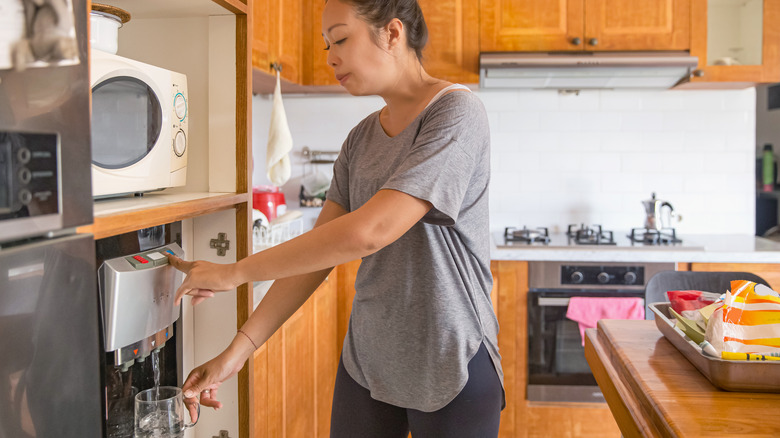What You Should Know About Potential Mold In Your Water Dispenser
We may receive a commission on purchases made from links.
You probably already know that mold can thrive in damp, warm environments, but there's one sneaky spot in your home where you may never guess it could lurk: your refrigerator water dispenser. These convenient ice makers and water dispensers in your kitchen can be potential breeding grounds for this fungus and other bacteria. Many households rely on water filters to filter out the harmful stuff without thinking twice about actually cleaning it. "Dirty fingers may touch the water dispenser," SpringWell Water Filtration explains. "Alae, sediment, minerals, and more can also build up in the refrigerator's hardworking filter, allowing bacteria to grow," they add. The result? Exposing everyone in your household to water contamination.
According to the U.S. Centers for Disease Control and Prevention (CDC), waterborne diseases are responsible for respiratory illnesses, bloodstream infections, and more, affecting over 7 million people in the U.S. every year. So, even if your water dispenser looks clean and is functioning normally, it's still in your best interest to check for signs of mold before drinking the water. This can look like brown or black flakes in your cup or glass. Water discoloration and sour or musty smell also indicate there's mold in your dispenser. If you notice any of these telltale signs, it's time to clean your fridge's water dispenser immediately.
How to clean your water dispensers
Fortunately, cleaning a water dispenser is pretty easy to do on your own. All you'll need are dish soap or white vinegar, water, a straw cleaner (like the Straw Cleaner Brush Kit) or pipe cleaner, a bowl, and a cloth rag. In the bowl, mix together the dish soap and water (or equal parts of vinegar) to make a cleaning solution. Saturate your brush or pipe cleaner with the solution and insert the brush into the water dispenser nozzle. Scrub up and down and repeat the process until the brush comes out clean.
The next step is to clean the water dispenser tray. You can do this by wiping the area thoroughly using your clean cloth rag dipped in the cleaning solution. Be sure to follow your user's manual since it will provide specific instructions on how to properly clean, sanitize, and replace the filter of your specific refrigerator. When it comes to keeping your water clean (and your family safe), regular cleaning is key. It's recommended to clean your water dispensers at least every three to six months to prevent mold and bacteria growth from rearing its ugly head. At-home water bacteria testing kits are also available, like this Highly Sensitive Home Tap & Well Water Test Kit, in case you think the water's contamination is more systemic.

